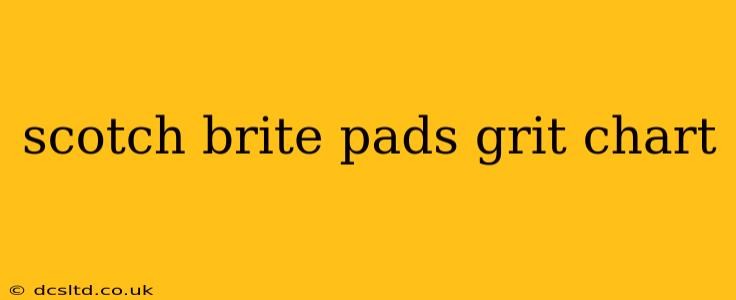Scotch-Brite pads are ubiquitous in homes and workshops worldwide, known for their versatility in cleaning and light-duty abrasion. However, choosing the right pad for a specific task can be tricky without understanding the different grit levels. This comprehensive guide will clarify the Scotch-Brite pad grit chart, helping you select the perfect pad for your needs. Unfortunately, 3M (the manufacturer of Scotch-Brite) doesn't provide a publicly available, precise grit chart in the traditional sense with numerical grit values (like sandpaper). Instead, they categorize their pads by their intended use and resulting level of abrasiveness. We'll break down this system and explore how to best interpret it.
Understanding Scotch-Brite Pad Abrasiveness
Scotch-Brite pads don't use a standard grit numbering system like sandpaper (e.g., 100 grit, 220 grit). Their abrasiveness is determined by the type of material used in the pad and its density. Generally, the pads are described using terms like "light," "medium," and "heavy," reflecting the aggressiveness of the cleaning or scrubbing action.
What Determines the Abrasiveness?
Several factors influence the abrasive nature of a Scotch-Brite pad:
- Material: Different materials, such as nylon, non-woven fibers, or even specialized scouring materials, provide varied levels of abrasiveness.
- Density: A denser pad will generally be more abrasive than a less dense pad made from the same material. Think of it like a sponge – a tightly packed sponge will scrub harder than a loose one.
- Texture: The texture of the pad’s surface plays a role. A pad with a more aggressive texture will offer more scrubbing power.
Scotch-Brite Pad Types and Their Relative Abrasiveness
While a precise numerical grit chart is absent, we can categorize Scotch-Brite pads based on their common applications and relative abrasiveness:
-
Extra-Light: These are generally used for delicate cleaning tasks. Think of wiping down countertops or cleaning windows. They have a minimal abrasive effect.
-
Light: These are suitable for general cleaning purposes, such as cleaning cookware or removing light food stains. They offer mild abrasion.
-
Medium: These pads handle more demanding cleaning tasks, such as removing stubborn stains or baked-on food. The abrasion is more noticeable.
-
Heavy-Duty: These are intended for heavy-duty scrubbing and cleaning. They are best for removing tough grime, rust, or paint. They offer significant abrasive power.
Choosing the Right Scotch-Brite Pad
The best way to select the appropriate pad is to consider the material you're cleaning and the level of soiling. For instance:
- Delicate surfaces (glass, polished metal): Use extra-light or light pads.
- Cookware (pots, pans): Light to medium pads are usually sufficient for most cleaning needs. Heavier duty pads are suitable for baked-on food.
- Tough stains (rust, paint): Heavy-duty pads are recommended for these tasks.
Frequently Asked Questions (FAQs)
Can I use Scotch-Brite pads on all surfaces?
No. Always test the pad on an inconspicuous area first to ensure it doesn't scratch or damage the surface. Avoid using abrasive pads on delicate finishes or materials like polished wood or some plastics.
What's the difference between Scotch-Brite pads and other scouring pads?
Scotch-Brite pads are known for their non-woven construction and often incorporate specialized materials for varied cleaning performance. Other scouring pads may use different materials and construction methods, resulting in varying levels of abrasiveness and durability.
How do I care for Scotch-Brite pads?
Rinse and air dry your pads after each use to extend their lifespan. Discard heavily soiled or worn-out pads.
Are Scotch-Brite pads recyclable?
The recyclability of Scotch-Brite pads depends on local recycling programs. Check with your local waste management services for information.
This guide provides a practical understanding of Scotch-Brite pad abrasiveness, helping you choose the right pad for various cleaning tasks. Remember to always check the packaging and product descriptions for specific recommendations on the pad's suitability for different surfaces.
